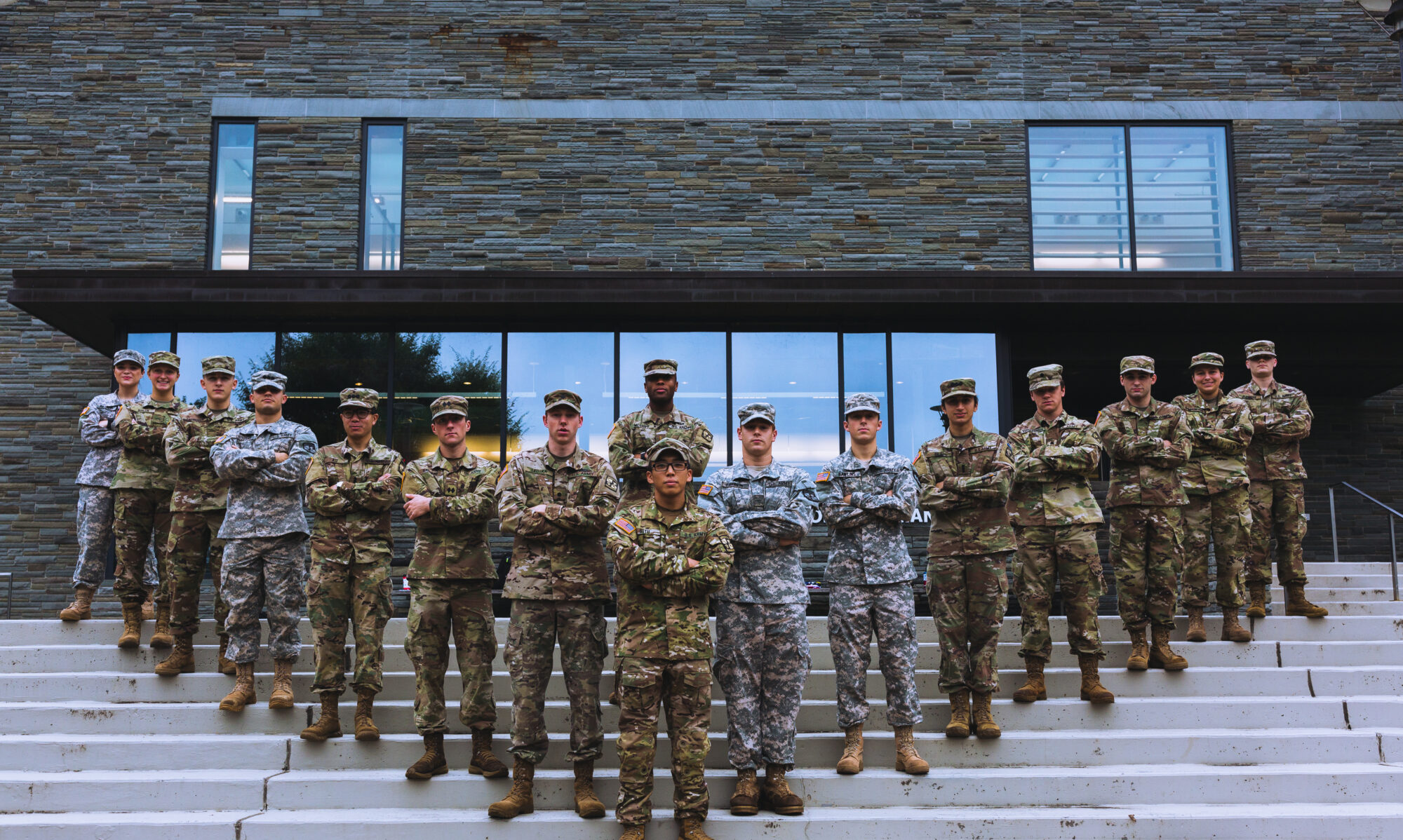Military Science Courses
BASIC COURSE
The basic course, normally taken in the freshman and sophomore years, provides training and instruction in leadership, public speaking, and basic military subjects, such as the Army’s role and organizational structure, history and philosophy of the Army, basic tactics, land navigation, first aid, group dynamics, and leadership traits and characteristics. Basic course students incur no military obligation and is only available to freshman and sophomore students.
ADVANCED COURSE
The advanced course is normally taken in the junior and senior years. The instruction includes management, military skills, advanced leadership and tactics, logistics, administration, military law, ethics, and professionalism, and includes attendance at the ROTC Cadet Leadership Course (CLC). Students receive subsistence pay during their junior and senior years.
To enroll in the advanced course, an applicant must complete either the basic course or the four-week Cadet Initial Entry Training (CIET); or have received basic course credit for previous military experience.
Note: The Advanced course (300 and 400 level) is a requirement for Scholarship and contracted cadets only and is not offered to participating students.
Physical Training (PT)
Physical fitness and readiness is part of being a good leader. PT is held three times a week, at different locations, from 0550-0700. Exercises range from Ability Group Runs to Cross-fit workouts to sprints and are designed to promote physical fitness and improved performance on physical assessments: the Army Physical Fitness Test (APFT) and the Army Combat Fitness Test (ACFT). PT also promotes camaraderie and unit cohesion.
Required Summer Training
There are two summer training camps: one is Cadet Initial Entry Training (referred to commonly as “Basic Camp) and the other is Cadet Summer training (referred to commonly as “Advanced Camp”.
Cadet Initial Entry Training (CIET): CIET is a way for current college students to begin participating in ROTC as late as their Junior year. It is a four week course that develops leadership skills, and enables immediate entry into the ROTC Advanced Course.
CIET is divided into three phases: Soldier First, Warrior Leader, and Bold Leader. The Soldier First phase immerses cadets in the Army lifestyle, where they learn basic soldier skills. The Warrior Leader Phase entails training in field skills. Training includes topics such as marksmanship, orienteering, rappelling and water survival. During the Bold Leader phase cadets begin to lead their teams through practical exercises. CIET is open to college students that are not currently enrolled in ROTC, as well as ROTC cadets that joined the program sometime during the middle of their freshman, sophomore, or junior year.
Cadet Summer Training (CST): From the Cadet Command Web Site: ROTC Cadet Summer Training is the most important training event for an Army ROTC cadet or National Guard Officer Candidate. The 33-day training event incorporates a wide range of subjects designed to develop and evaluate leadership ability. The challenges are rigorous and demanding, both mentally and physically. CST tests intelligence, common sense, ingenuity and stamina. These challenges provide a new perspective on an individual’s ability to perform exacting tasks and to make difficult decisions in demanding situations.
CST places each cadet and officer candidate in a variety of leadership positions, many of which simulate stressful combat situations. In each position, cadets will receive evaluations from platoon tactical and counseling (TAC) officers and noncommissioned officers. In addition to proving their leadership ability, cadets and officer candidates must meet established standards in physical fitness, weapons training, communication, combat patrols and demonstrate their proficiency in many other military skills. Cadets and officer candidates must excel at CST to be considered competitive for a commission as an Army officer.
Elective Training Opportunities
There are a number of training opportunities, typically over the summer, available to qualified cadets. Cadets are picked based upon their Order of Merit List (OML) standing, cadre input, and overall performance. Lafayette cadets have participated in the following programs and schools:
Airborne School: cadets attend Airborne school at Ft. Benning, GA, to become parachute-jump qualified. School is three weeks long.
Air Assault School: cadets attend Air Assault school at different locations to become qualified in rappelling from a helicopter. School is ten days long.
Cadet Coalition Warfighter Program: cadets are selected for a deployment to a foreign country in order to facilitate positive relations with U.S. allies, professional development, and training. These trips are three weeks long and include cultural immersion events along with interaction and training with foreign military hosts. Countries include Romania, Nepal, Poland, Honduras, Argentina, the Philippines, and many others.
Cadet Intern Program (CIP): an initiative of ASA/MRA, allows cadets to work with the Department of the Army (DA), the Secretariat, Office of the Chief of Army Reserves (OCAR), National Guard Bureau (NGB), and the Office of the Secretary of Defense (OSD) for three weeks. These cadets receive an OER at completion.
Cadet Leader Training (CTLT): cadets selected for this three-week program participate in the summer after their MSIII year. Cadets shadow officers, typically second lieutenants, take part in training, are given some tasks and responsibilities, and observe what Active Duty life is like. Nearly all branches are available at posts both stateside and abroad.
